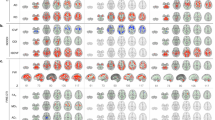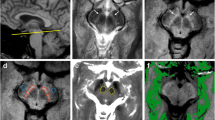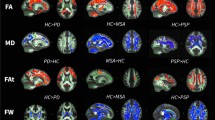Abstract
Since the attempt to evidence structural brain damage in Parkinson's disease (PD) by conventional magnetic resonance imaging (MRI) is usually disappointing, we have investigated whether the magnetization transfer ratio (MTR) can reflect changes in grey and white matter of PD patients. MTR was quantified in 44 regions of interest (ROIs) in both grey and white matter of 11 non-demented PD patients, ranging from 2 to 4 on the Hoehn and Yahr Scale, and eight age-matched healthy subjects. MTR differences between patients and controls were found in the supratentorial white matter and in the brainstem. In particular, lower MTR values were found in the paraventricular white matter of PD patients (p<0.05) while no differences were observed in corpus callosum, frontal, parietal, occipital lobes or centrum semiovalis. Lower MTR values were found in substantia nigra (p<0.001), red nucleus (p<0.05) and pons (p<0.05) of the patient group. No differences were discovered in basal ganglia and thalamus. These findings suggest that MTR measurements in the paraventricular white matter and brainstem may help to recognize a marker for probable PD.


Similar content being viewed by others
References
Fearnley JM, Lees AJ (1991) Ageing and Parkinson's disease: substantia nigra regional selectivity. Brain 114: 2283–2301
Hughes AJ, Daniel SE, Kilford L, et al (1992) Accuracy of clinical diagnosis of idiopathic Parkinson's disease: a clinico-pathological study of 100 cases. J Neurol Neurosurg Psychiatry 55: 181–184
The deep-brain stimulation for Parkinson's disease study group (2001) Deep-brain stimulation of the subthalamic nucleus or the pars interna of the globus pallidus in Parkinson's disease. N Engl J Med 345: 956–963
Antonini A, Leenders KL, Vontobel P, et al (1997) Complementary PET studies of striatal neuronal function in the differential diagnosis between multiple system atrophy and Parkinson's disease. Brain 120: 2187–2195
Gasser T (2001) Molecular genetics of Parkinson's disease in Parkinson's disease. Adv Neurol 86: 23–32
Braffman BH, Grossman RI, Goldberg HI, et al (1988) MR imaging of Parkinson disease with spin-echo and gradient-echo sequences. AJNR Am J Neuroradiol 9: 1093–1099
Antonini A, Leenders KL, Meier D, et al (1993) T2 relaxation time in patients with Parkinson disease. Neurology 43: 697–700
Gorell JM, Ordidge RJ, Brown GG, et al (1995) Increased iron-related MRI contrast in the substantia nigra in Parkinson's disease. Neurology 45: 1138–1143
Olanow CW, Drayer B (1988) Magnetic resonance imaging studies of iron distribution in Parkinson's disease and aging. Arch Neurol 45: 809
Ryvlin P, Broussolle E, Piollet H, et al (1995) Magnetic resonance imaging evidence of decreased putaminal iron content in idiopathic Parkinson's disease. Arch Neurol 52: 583–588
Duguid JR, De La Paz R, De Groot J (1986) Magnetic resonance imaging of the midbrain in Parkinson's disease. Ann Neurol 20: 744–747
Huber SJ, Chakeres DW, Paulson GW, et al (1990) Magnetic resonance imaging in Parkinson's disease. Arch Neurol 47: 735–737
Schulz JB, Skalej M, Wedekind D, et al (1999) Magnetic resonance imaging-based volumetry differentiates idiopathic Parkinson's disease from multiple system atrophy and progressive supranuclear palsy. Ann Neurol 45: 65–74
Konagaya M, Konagaya M, Iida M (1994) Clinical and magnetic resonance imaging study of extrapyramidal symptoms in multiple system atrophy. J Neurol Neurosurg Psychiatry 57: 1528–1531
Schrag A, Good CD, Miszkiel K, et al (2000) Differentiation of atypical parkinsonian syndromes with routine MRI. Neurology 54: 697–702
Kraft E, Schwarz J, TrenkWalder C, et al (1999) The combination of hypointense and hyperintense signal changes on T2-weighted magnetic resonance imaging sequences. Arch Neurol 56: 225–228
Barbeau A (1986) Parkinson's disease: clinical features and aetiopathology. In: Vinken PJ, Bruyn GW, Klawans HL (eds) Handbook of clinical neurology, vol 49. Elsevier Science, Amsterdam, pp 87–152
Rutledge JN, Hillal SK, Silver AJ, et al (1987) Study of movement disorders and brain iron by MR. AJNR Am J Neuroradiol 8: 397–410
Steiner I, Gomori JM, Melamed E (1985) Features of brain atrophy in Parkinson's disease. Neuroradiology 27: 158–160
Stern MB, Braffman BH, Skolnick BE, et al (1989) Magnetic resonance imaging in Parkinson's disease and parkinsonian syndromes. Neurology 39: 1524–1526
Piccini P, Pavese N, Canapicchi R, et al (1995) White matter hyperintensities in Parkinson's disease. Arch Neurol 52: 191–194
Adachi M, Hosoya T, Haku T, et al (1999) Evaluation of the substantia nigra in patients with parkinsonian syndrome accomplished using multishot diffusion-weighted MR imaging. AJNR Am J Neuroradiol 20: 1500–1506
Hutchinson M, Raff U (1999) Parkinson's disease: a novel MRI method for determining structural changes in the substantia nigra. J Neurol Neurosurg Psychiatry 67: 815–818
Wolff SD, Balaban RS (1989) Magnetization transfer contrast in magnetic resonance contrast (MTC) and tissue water proton relaxation in vivo. Magn Reson Med 10: 135–144
Meyer JR, Androux RW, Salamoi N, et al (1997). Contrast-enhanced magnetization transfer MR of the brain: importance of precontrast image. AJNR Am J Neuroradiol 18: 1515–1521
Hanyu H, Asano T, Sakurai H, et al (1999) Magnetization transfer ratio in cerebral white matter lesion of Binswanger's disease. J Neurol Sci 166: 85–90
Hanyu H, Asano T, Iwamoto T, et al (2000) Magnetization transfer measurements of the hippocampus in patients with Alzheimer's disease, vascular dementia and other types of dementia. AJNR Am J Neuroradiol 21: 1235–1242
Van Der Flier WM, Van Den Heuvel DM, Weverling-Rijnsburger AW, Bollen EL, Westendorp RG, Van Buchem MA, Middelkoop HA (2002) Magnetization transfer imaging in normal aging, mild cognitive impairment, and Alzheimer's disease. Ann Neurol 52: 62–67
Kabani NJ, Sled JG, Shuper A, Chertkow H (2002) Regional magnetization transfer ratio changes in mild cognitive impairment. Magn Reson Med 47: 143–148
Folstein MF, Folstein SE, McHugh PR (1975) "Mini Mental State": a practical method for grading the cognitive state of patients for the clinician. J Psychiatr Res 12: 189–198
Gelb DJ, Oliver E, Gilman S (1999) Diagnostic criteria for Parkinson disease. Arch Neurol 56: 33–39
Fahn S, Elton R, Members of the UPDRS Development Committee. (1987) In: Fahn S, Marsden CD, Calne DB, Goldstein M (eds) Recent developments in Parkinson's disease, vol 2. Macmillan Health Care Information, Florham Park, NJ, 153–163, 293–304
Drayer B, Burger P, Darwin R, et al (1986) Magnetic resonance imaging of brain iron. AJNR Am J Neuroradiol 7: 373–380
Hirsch E, Hunot S, Damier P, et al (1999) Glial cell participation in the degeneration of dopaminergic neurons in Parkinson's disease. Adv Neurol 80: 9–18
Olanow CW (1993) A radical hypothesis for neurodegeneration. Trends Neurol Sci 16: 439–444
Dexter DT, Carter CJ, Wells FR, et al (1989) Basal lipid peroxidation in substantia nigra is increased in Parkinson's disease. J Neurochem 52: 381–389
Jellinger KA (2001) The pathology of Parkinson's disease. Adv Neurol 86: 55–72
Sofic E, Paulus W, Jellinger K, et al (1991) Selective increase of iron in substantia nigra zona compacta of parkinsonian brain. J Neurochem 56: 978–982
Jellinger K, Kienzl E, Rumpelmaier G, et al (1992) Iron-melanin complex in substantia nigra of parkinsonian brains: an X-ray microanalysis. J Neurochem 59: 1168–1171
Chen JC, Hardy PA, Kucharczyk W, et al (1993) MR of human post-mortem brain tissue: correlative study between T2 and assays of iron and ferritin in Parkinson and Huntington disease. AJNR Am J Neuroradiol 14: 275–281
Brooks DJ, Luthert P, Gadian D, et al (1989) Does signal attenuation on high field T2-weighted MRI of the brain reflect regional cerebral iron deposition? Observations on the relationship between regional cerebral water proton T2-values and iron levels. J Neurol Neurosurg Psychiatry 52: 108–111
Silver NC, Barker GJ, MacManus DG, et al (1997) Magnetisation transfer ratio of normal brain white matter: a normal database spanning four decades of life. J Neurol Neurosurg Psychiatry 62: 223–228
Mehta RC, Pike BC, Enzmann DR (1995) Magnetization transfer MR of the normal adult brain. AJNR Am J Neuroradiol 16: 2085–2091
Cornford ME, Chang L, Miller BL (1995) The neuropathology of parkinsonism: an overview. Brain Cogn 28: 321–341
Pahapill PA, Lozano AM (2000) The peduncolopontine nucleus and Parkinson's disease. Brain 123: 1767–1783
Nakahara M, Hayashi H, Kumazaki T, et al (1999) Value of magnetization transfer contrast as a sensitive technique to reflect histopathological changes in the white matter adjacent to the frontal horn of lateral ventricles. J Nippon Med Sch 66: 27–34
Wong KT, Grossman RI, Boorstein JM, et al (1995) Magnetization transfer imaging of periventricular hyperintense white matter in the elderly. AJNR Am J Neuroradiol 16: 253–258
Mehta RC, Pike GB, Enzmann DR (1996) Measure of magnetization transfer in multiple sclerosis demyelinating plaques, white matter ischemic lesions and edema. AJNR Am J Neuroradiol 17: 1051–1055
Hanyu H, Asano T, Sakurai H, et al (2001) Magnetization transfer measurements of the subcortical grey and white matter in Parkinson's disease with and without dementia and in progressive supranuclear palsy. Neuroradiology 43: 542–546
Sinson G, Bagley LJ, Cecil KM, et al (2001) Magnetization transfer imaging and proton MR spectroscopy in the evaluation of axonal injury: correlation with clinical outcome after traumatic brain injury. AJNR Am J Neuroradiol 22: 143–151
Sormani MP, Iannucci G, Rocca MA, et al (2000) Reproducibility of magnetization transfer ratio histogram-derived measures of the brain in healthy volunteers. AJNR Am J Neuroradiol 21: 133–136
Foong J, Maier M, Barker GJ, et al (2000) In vivo investigation of white matter pathology in schizophrenia with magnetisation transfer imaging. J Neurol Neurosurg Psychiatry 68: 70–74
Ernst T, Chang L, Witt M, et al (1999) Progressive multifocal leucoencephalopathy and human immunodeficiency virus-associated white matter lesions in AIDS: magnetization transfer MR imaging. Radiology 210: 539–543
Okumura A, Takenaka K, Nishimura Y, et al (1999) The characterization of human brain tumor using magnetization transfer technique in magnetic resonance imaging. Neurol Res 21: 250–254
Hähnel S, Münchel K, Jansen O, et al (1999) Magnetization transfer measurements in normal-appearing cerebral white matter in patients with chronic obstructive hydrocephalus. J Comput Assist Tomogr 23: 516–520
Mehta RC, Pike BG, Enzmann DR (1996) Magnetization transfer magnetic resonance imaging: a clinical review. Top Magn Reson Imaging 8:214–230
Kucharczik W, MacDonald PM, Stanisz GJ, et al (1994) Relaxivity and magnetization transfer of white matter at MR imaging: importance of cerebrosides and pH. Radiology 192: 521–529
Elster AD, King JC, Mathews VP, et al (1994) Cranial tissue: appearance at gadolinium-enhanced and non-enhanced MR imaging with magnetization transfer contrast. Radiology 190: 541–546
Fralix TA, Ceckler TL, Wolff SD, et al (1991) Lipid bilayer and water proton magnetization transfer: effect of cholesterol. Magn Reson Med 1: 214–223
Gochberg DF, Kennan RP, Marjanski MJ, et al (1998) The role of specific side groups and pH in magnetization transfer in polymers. J Magn Reson 131: 191–198
Author information
Authors and Affiliations
Corresponding author
Rights and permissions
About this article
Cite this article
Tambasco, N., Pelliccioli, G.P., Chiarini, P. et al. Magnetization transfer changes of grey and white matter in Parkinson's disease. Neuroradiology 45, 224–230 (2003). https://doi.org/10.1007/s00234-002-0925-5
Received:
Accepted:
Published:
Issue Date:
DOI: https://doi.org/10.1007/s00234-002-0925-5




